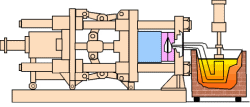Advantages of Zinc Die Casting. There are many industrial processes involving the manufacture of zinc. These include die casting, forging, extrusion, plastic injection molding, permanent mold casting and stamping. However, zinc die casting is probably the most advantageous of these processes.
Unlike in forging, parts made by zinc die casting are more complex in shape and these shapes are not forgeable. They could also be held together in closer dimensions, and have thinner sections.
Compared with extrusion, zinc die casting produces in net shape, making the whole production process easier and faster. Hollows, depressions and other features on the tops, bottoms and sides of the zinc parts can be crafted in a single operation.
Compared with plastic injection molding, die cast parts are more durable, stiffer and more dimensionally stable. These are also more heat-resistant and on properties and chrome plating basis, these are still way superior to plastics. Die cast parts are environment-friendly since they prevent radio frequency and electromagnetic emissions. Compared to plastics, die cast parts have higher degree permanence. They are fully resistant to weathering, UV rays, and cracking due to stress. The production rate of die cast parts is also faster than of plastic injection molding.
Compared with permanent mold casting, zinc die casting makes parts with thinner sectioning, closer dimensional limits, and holes can be die cast to near net shape.
Compared with stamping, one die cast part can most of the time, replace several parts. Die casting requires less or no assembly procedures. Many shapes that can be achieved by die casting cannot be produced in stamped form.


